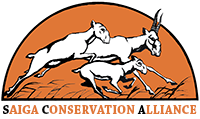The huge increase in numbers of the Ural saiga population – from just over 6,000 in 2003 to over 1 million today – is a major conservation success story, and is testament both to the hard work of the Okhotzooprom rangers in the area and the tolerance and support of local residents in West Kazakhstan. We must celebrate this recovery of the population, but we also recognise that the very large herds of saiga now present in the area bring challenges as well. In an area where livelihoods depend upon livestock herding and haymaking and livestock numbers are increasing, the presence of so many saigas can lead to competition for pasture and water, and the potential for disease transmission between livestock and saigas, which is dangerous to both. Recognising the need for a protected zone for saigas, the Government of Kazakhstan has recently set up the Boky Orda reserve, and has also engaged with farmers, academics, NGOs and international experts to explore how to ensure a sustainable future for people and wildlife in West Kazakhstan.
This resulted in a Strategy for the Conservation and Management of saigas in Kazakhstan, found here: https://www.cms.int/cami/en/document/strategy-conservation-and-management-saiga-kazakhstan
Saigas and humans have coexisted for millenia and this has always included humans hunting saigas for meat and other products. The CMS MoU on the Conservation and Sustainable Use of saigas, of which the SCA is a Cooperating Organisation and Technical Coordinator, envisages saigas playing a full role in the ecosystem, including through sustainable use. Therefore the SCA supports the consumptive use of saigas, if done in accordance with best practice principles, for the benefit of local residents, as envisaged in the Strategy for the Conservation and Management of saigas in Kazakhstan.
However, the SCA has concerns about the current large-scale culling of saigas in the Ural region, and in particular about the continuation of this cull into the rutting season for the species, and potentially further into the winter. This is against longstanding best practice and has the potential to have a very severe impact on the welfare of individuals and the reproductive output of the population next year, both through disturbance to the rut but then also stress to pregnant females.
The Saiga Conservation Alliance urges the Government of Kazakhstan to shift its priorities away from population size reduction by culling, towards sustainable use of saigas. This could include harvesting of saigas, as well as other extractive and non-extractive uses of the species to benefit local residents and motivate coexistence with saiga on shared lands.
The Saiga Conservation Alliance furthermore urges the Government of Kazakhstan to ensure that any harvest of the saiga is in line with the Strategy for the Conservation and Management of saigas in Kazakhstan and follows the norms and best practice for harvest that were developed during large-scale hunting in previous years, informed also by international best practice.
In this regard, the report prepared by the SCA for the Convention on Migratory Species could be helpful: https://www.cms.int/saiga/en/publication/sustainable-use-saiga-antelopes-perspectives-and-prospects.
